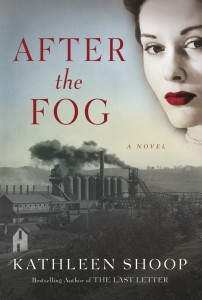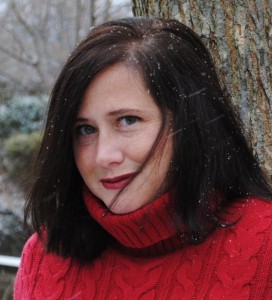I’m thrilled to be interviewing author Kathleen Shoop today. She’s a language arts coach, and has a PhD in Reading Education. Her debut novel, The Last Letter, won multiple awards, including the 2011 IPPY Gold Medal Award for Best Regional Fiction, Midwest. She’s published in four Chicken Soup for the Soul books, and regularly places articles and essays in local magazines and newspapers. Join us now as she discusses her historical novel, After the Fog.
AR: Themes about forgiveness and healing run through After the Fog. What impelled you to write about these issues?
K: I read the newspaper (yes the old-fashioned kind) almost every morning. The stories that move me most deal with flawed people who have made big mistakes in life but are doing something to right them. Of course, if these things are in the paper then they’re huge things to heal or repent for, but that idea that it’s possible, that we all need to do it in some way is compelling to me. I try to figure out what exactly about a certain story inspired me or brought me to tears—I want to do that in my fictional stories!
AR: Rose is complex character; headstrong; controlling; riddled with painful secrets; a nurse, but ironically in need of healing. How did she come about?
K: Rose’s hard shelled, no-nonsense, sometimes hurtful personality came from women, (like my grandmother) I knew growing up in Pittsburgh—they were extremely tough and could be pointed, but they loved their families. Just not always in the way the family members wanted to be loved. My grandmother adores nothing more than snuggling a baby/toddler, but don’t dare be a toddler who’d rather explore the house than snuggle her! The woman worked her fingers to blisters and simply could not tolerate anything less than the same steely nature. There was nothing like finally getting a compliment from her because it took so much to get one! She still strikes fear/love in the hearts of children, cousins, grand kids and she’s 95!
My grandmother was orphaned by the flu epidemic, she grew up with her siblings at her grandparents. And though she says, “I raised myself,” the specific back story details I gave to Rose (other than being an orphan) in After the Fog are complete fiction. With that said, I think being an orphan, having in reality or perception “raised myself,” would have contributed to my gram’s hard shell without a doubt.
In creating what Rose needed to heal from I took the context of who she was: a woman in early/mid 20th century, an orphan who committed what she sees as a cowardly act as a teenager, she sees herself as being duped by the first person she trusted and with that, she barrels through life, hoping her work and actions redeem her past wrongs.
AR: The historical “killing smog” was a powerful use of place to set mood and move the story along. What inspired you to write about it, and how does it serve as a central metaphor in the novel?
K: I had finished writing The Last Letter in which the Children’s Blizzard of 1888 turned a major plot point in the book. I mentioned to my mother that I needed another disaster for my next book and she suggested the infamous 1948 Donora, PA “five days of fog.” Once I researched it, I saw it was the perfect backdrop for my next book. The fog does work as a metaphor—Rose has sort of lived in a fog, blindly pushing through life in ways she thinks are right because she can’t see past the fear in her heart. Only once everything was taken away from her and the fog cleared long enough for her to see what she was missing could she begin to heal—to recognize she had everything she needed right in front of her.
AR: Meticulous research would be needed to evoke the 1948 Donora, Pennsylvania steel town. How did you approach that?
K: I grew up in Pittsburgh at a time when the mills were booming then suddenly gone. Though my home was up the hill from the closest mill town, Etna, it’s where my father grew up. You couldn’t drive toward Pittsburgh and its surrounding areas without hitting a mill. Whether up and running or an abandoned carcass, there is nothing so awe-inspiring as the sight of a 20th century steel mill.
Donora is south of Pittsburgh and though still there, the mill property is now an industrial park, with grave markers of steel workers who fell into vats of steel and were buried encased in it, weeds sprout of concrete, and though new buildings are there, the space still exudes mystery to me.
I am so lucky that the Donora Historical Society allowed me access to their records, their photos, their stories, their people. I’ve visited Donora several times, had the most incredible tours from Dr. Charles Stacey who was born in the home he still lives in. Brian Charlton (historian) read a draft of After the Fog and pointed out any issues with details related to Donora, the fog, the times.
My conversations with them (and residents of other mill-towns) helped me shape much of the struggle between Johnny and his mother—the idea that residents were so proud of the work they did, yet they wanted their children to go to college and have a “better” life. It’s a strange contradiction to work with.
Then there was all the science and research related to mills and the 1948 killing smog. Most people around Donora don’t even know it happened! This event that spurred the development of the EPA and the Clean Air Act of 1955 is largely unknown in the very area it happened. Part of that is time marching on, part of it was that residents didn’t want the mills to go away. “Smoke was money,” was the attitude of many—these were immigrants who came from around the world to have a better life. And, they weren’t going to give it up for some smoke. So, after the smog cleared, everyone went back to work.
I compared articles from the time of the smog, government reports, and books written on industrial pollution to the interviews I did—I looked at what matched up and what didn’t and tried to layer the information into the story in an unforced way. I wanted the family’s personal struggles to rev up as the fog was settling in, suffocating people, forcing everyone to make decisions they wouldn’t have normally made. Like real life! I hope I managed that.
AR: What launched you into becoming a writer, and how have you honed the craft?
K: I’ve always written in terms of constructing stories in my mind. I am a voracious reader and always have been—I love nearly every genre there is. For me, it was this idea that people get sick of hearing your voice, but if you can write down what’s important to you, a story, or an essay or whatever, people can read you at their leisure. You get to say what you want, but you don’t bother anyone with it!
I seriously began writing ten years ago—that’s when I knew I could not, not write. I’ve gone to workshops, conferences, and participated in critique groups. Mostly, I read and study other writers—the way they move me and hope I can find a way to do the same.
AR: Your synopsis is so tight, promising a beautiful melding of character, story, and theme. Give us a glimpse into how you approached attaining that harmony in the novel!
K: Thanks, Peter, I hope the novel delivers on the synopsis’ promise! I think I’ve attained harmony for some readers and probably not for others. I did my best not to dump any info into the story just because it was interesting on its own. There were so many facts and instances and events that were compelling that I wanted to use or tell the reader, but I couldn’t because it didn’t further the plot or illuminate a character. The rule I tried to live by was—if I wanted to show something about the time or place, say with a type of kitchen implement, I needed to show a character using it. I tried to steer away from paragraphs of window-dressing, yet still give the flavor for the time and place—a setting readers have either forgotten or never knew. If something’s in a scene or a person is saying something, it was my attempt to move the plot or show a character’s growth or lack of it!
AR: What’s ahead for you?!
K: I’m going to put out a women’s fiction novel by the fall—something I wrote a while back. And, now I’m writing a follow-up to The Last Letter. Thanks so much, Peter!
AR: Thank you! Readers can purchase your books and follow you at the links below!
Purchase Kathleen’s books on Amazon
Kathleen’s Website.
Kathleen on Facebook
Kathleen on Twitter



